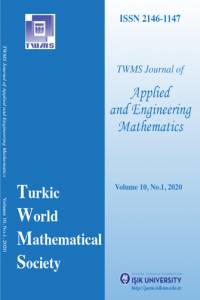Linear Retrial Inventory System with Second Optional Service Under Mixed Priority Service
Markov process, continuous review, inventory with service time, prioritycustomers, essential and optional service finite populations,
___
- Artalejo, J.R., Dudin, A.N. and Klimenok, V.I., (2001), Stationary analysis of a retrial queue with preemptive repeated attempts, Oper. Res. lett., 28, (1), pp. 173-180.
- Berman, O. and Kim, E., (1999), Stochastic models for inventory management at service facility, Stoch. Model., 15, (4), pp. 695-718.
- Berman, O. and Kim, E., (2004), Dynamic inventory strategies for profit maximization in a service facility with stochastic service, Math. Methods. Oper. Res., 60, (3), pp. 497-521.
- Berman, O. and Kim, E., (2001), Dynamic order replenishment policy in internet-based supply chains
- Math. Methods. Oper. Res., 53, (3), pp. 371-390. Berman, O. and Sapna, K.P., (2000), Inventory management at service facility for systems with arbitrarily distributed service times, Commun. Stat. Stoch. Models., 16, (3), pp. 343-360.
- Berman, O. and Sapna, K.P., (2001), Optimal control of service for facilities holding inventory, Com- put. Oper. Res., 28, (5), pp. 429-441.
- C¸ akanyildirim, M., Bookbinder, J.H. and Gerchak, Y., (2000), Continuous review inventory models where random lead time depends on lot size and reserved capacity, Int. J. Prod. Econ., 68, (3), pp. 228.
- Choi, B.D. and Chang, Y., (1999), Single server retrial queues with priority customers, Math. Comput. Model., 30, pp. 7 - 32.
- Dur´an, A., Guti´errez, G. and Zequeira, R. I., (2004), A continuous review inventory model with order expediting, Int. J. Prod. Econ., 87, (2), pp. 157 - 169.
- Elango, C. and Arivarignan, G., (2003), A Continuous Review Perishable Inventory Systems with Pois- son Demand and Partial Backlogging, Stat. Methods. Pract: Recent Advances, in : N. Balakrishnan
- N. Kannan and M.R.Srinivasan, (ED.), Narosa Publ. House, New Delhi. Falin, G.I., Artalejo, J.R. and Martin, M., (1993), On the single server retrial queue with priority customers, Queueing Syst, 14, pp. 439-455.
- Goyal, S. K. and Giri, B. C., (2001), Recent trends in modeling of deteriorating inventory, European J. Oper. Res., 34, (1), pp. 1 - 16.
- Jeganathan, K., Anbazhagan, N. and Kathiresan, J., (2013), A retrial inventory system with non- preemptive priority service, Int. J. Inf. Manag. Sci., 24, (1), pp. 57 - 77.
- Jau-Chuan, K., Chia-Huang, W. and Wen Lea, P., (2011), Multi-server retrial queue with second optional service: algorithmic computation and optimisation, Internat. J. Systems Sci., 42, (10), pp. 1769.
- Jinting, W. and Qing Zhao, J., (2007), A discrete-time Geo/G/1 retrial queue with starting failures and second optional service, Comput. Math. Appl., 53, (1), pp. 115 - 127.
- Kalpakam, S. and Arivarignan, G., (1990), Inventory System with Random Supply Quantity, OR Spektrum, 12, pp. 139-145.
- Kalpakam, S. and Arivarignan, G., (1993), A coordinated multicommodity (s,S) inventory system
- Mathl. Comput. Modelling, 18, pp. 69-73. Krishnamoorhy, A., Narayanan, V.C., Deepak, T.G. and Vineetha, P. (2006), Control policies for inventory with service time, Stoch. Anal. Appl., 24, (4), pp. 889-899.
- Langaris, C. and Moutzoukis, E., (1995), A retrial queue with structured batch arrivals, priorities and server vacations, Queueing Syst, 20, pp. 341-368.
- Liu, L. and Yang, T., (1999), An (s, S) random lifetime inventory model with a positive lead time
- European J. of Oper. Res., 113, pp. 52-63. Nahmias, S., (1982), Perishable Inventory Theory: A Review, Oper. Res., 30, pp. 680-708.
- Ning, Z. and Zhaotong, L., (2011), A queueing-inventory system with two classes of customers, Int. j. Prod. Econ., 129, pp. 225-231.
- Raafat, F., (1991), A Survey of Literature on Continuously Deteriorating Inventory Models, J. Oper. Res. Soc., 42, pp. 27-37.
- Ross, S. M., (2000), Introduction to probability models, Harcourt Asia PTE Ltd, Singapore.
- Yadavalli, V. S. S., CdeW V. S., Strashein, J. J. and Udayabakaran, S., (2004), A single product perishing inventory model with demand interaction, ORiON, 20, (2), pp. 109 - 124.
- ISSN: 2146-1147
- Başlangıç: 2010
- Yayıncı: Turkic World Mathematical Society
I. Z. GÖKBAY, S. L. KARAMAN, S. YARMAN, B. S. YARMAN
- R.SUNDARESWARAN, - V.SWAMİNATHAN
W.b. DOMİ, S. AL-SHARİF, H. ALMEFLEH
